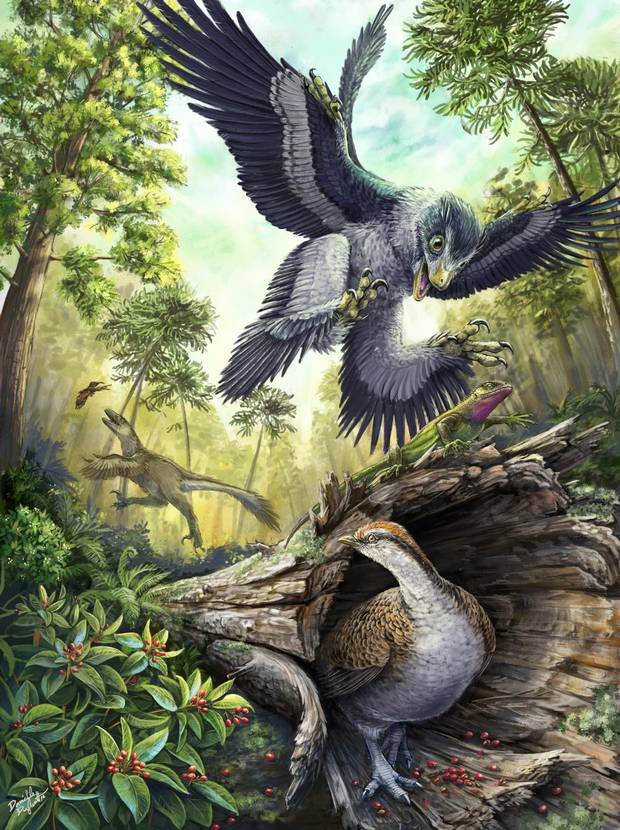
A small feathered dinosaur swoops down on an unsuspecting lizard while a bird hunts for seeds in this reconstructed slice of life in Alberta 66 million years ago. A new theory suggests that a seed diet helped birds survive the mass extinction event that wiped out all other dinosaurs.
DANIELLE DUFAULT
Call it survival of the seediest.
Even though dinosaurs were wiped out when a massive asteroid collided with Earth about 66 million years ago, their only living representatives, birds, managed to squeak through the ensuing cataclysm.
Now a team of Canadian paleontologists has offered an explanation: Today's birds dodged extinction, the researchers say, because their ancestors were equipped with toothless beaks that helped them dine on seeds when other sources of food went up in flames.
If correct, the idea casts a new light on the evolution of birds and adds a vivid layer of detail to the emerging picture of an environmental catastrophe that utterly reshaped the course of life on Earth.
"Seeds are a nutrient-rich package of energy that would be immediately available – and available for months to decades – after that asteroid hit," said David Evans, a curator of vertebrate paleontology at the Royal Ontario Museum in Toronto and co-author of a paper that advances the new theory, published on Thursday in the journal Current Biology.
It is estimated that three-quarters of all plant and animal species were extinguished when a 10-kilometre-wide asteroid smacked into what is now Mexico's Yucatan Peninsula, hollowing out a 180-km-wide crater than is still imprinted in the bedrock there.
The high-velocity impact would have triggered earthquakes and tsunamis, and launched a global blanket of debris that re-entered the atmosphere at high temperature and ignited continent-scale wildfires. Researchers have previously suggested that dust and soot would have darkened the atmosphere for months afterward, shutting down photosynthesis and most of the food chain along with it.
The victims included all dinosaur species except some birds, even though many small, feathered dinosaurs were present at the same time and shared similar traits and habitat with their bird cousins. The precise reason that birds lived to chirp on has been a long-standing paleontological puzzle.
The notion that seeds might play a key role came up during a conversation at the ROM two years ago when Derek Larson, a PhD student working with Dr. Evans, was presenting his work on the teeth of small bird-like dinosaurs.
The researchers in the room began discussing how one might scientifically reconstruct what happened to those dinosaurs when the asteroid hit when another PhD student, Tom Cullen, jokingly said, "Why don't we burn a forest down?"
"It was a flippant comment, but that's when the light went on," Dr. Evans said. "It was a true eureka moment."
A survey of the ecological literature showed that seed-eating birds are indeed among the first vertebrates to recolonize landscapes consumed by wildfires. The group also conducted a detailed analysis of the avian family tree to demonstrate that all the birds present on Earth today were most likely descended from seed-eating ancestors.
Finally, there were the teeth. Mr. Larson had painstakingly examined and measured more than 3,000 fossil teeth from maniraptorans – the family of dinosaurs from which birds sprang – representing an 18-million-year period leading up to the mass extinction. The results show that the maniraptorans were diverse and well adapted to their various environments and prey.
Unlike another study published earlier this week, which suggests that some dinosaur species were already in trouble before the asteroid hit, the Canadian team saw no such evidence for the birdlike dinosaur.
Instead, they found that those particular dinosaurs seemed to be in the midst of a very successful run when they were abruptly killed off. In contrast, birds with no teeth that were used to crunching away on seeds instead of exclusively feasting on smaller animals went on to repopulate the planet.
"I think it's as good an idea as we have for why some birds made it through," said Stephen Brusatte, a paleontologist at the University of Edinburgh who was not involved in the work.
Dr. Brusatte added that in the past two decades the thinking in the field has gradually shifted away from asking why the dinosaurs died to focusing on why one particular group of dino saurs, which we know today as birds, managed to do so well. Evolutionarily speaking, birds are the most successful terrestrial vertebrates on Earth and are represented by about 10,000 species.
Mr. Larson, who is now an assistant curator at the Philip J. Currie Dinosaur Museum near Grande Prairie, Alta., said the best possible evidence to test the theory would be a series of beaked skulls that could show how birds transitioned across the geological boundary that corresponds to the mass extinction. But unlike fossil teeth, fossil beaks are exceedingly rare.
He also noted that laws that prevent private sales of fossils found in the province, no matter how small, are part of the reason that he and his colleagues had access to the evidence they needed. In the United States and in many other parts of the globe, there is a thriving commercial market for dinosaur fossils, which are often lost to science when they become part of personal collections.
"You can get very meaningful data from small and seemingly insignificant fossils that will actually tell you something about the evolution of these animals," Mr. Larson said.
PREHISTORY LESSONS: MORE FROM IVAN SEMENIUK
What were these camel bones doing in the Arctic, and what does it mean for climate change?
2:11



